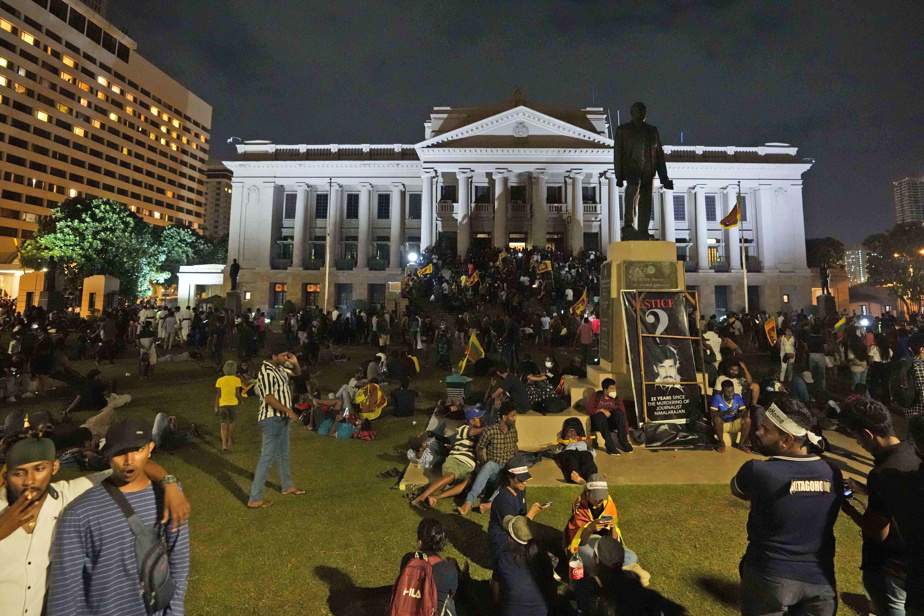(Colombo) Sri Lankan President Gotabaya Rajapaksa on Saturday agreed to step down next week, hours after he was forced to flee his crowded residence after mass protests in Colombo sparked by the catastrophic crisis that has gripped the country.
Amal Jiasingi France media agency
“To ensure a peaceful transition, the president said he will step down on July 13,” Parliament Speaker Mahinda Abiordana said on television.
Photo DINUKA LIYANAWATTE, Reuters archive
Sri Lanka President Gotabaya Rajapaksa
Two of the president’s relatives resigned without delay: the head of the press service Sudewa Hitarachi and the information minister, Pandola Gunawardana, who also left his post at the head of the presidential party.
For his part, Prime Minister Ranil Wickremesinghe tried to pave the way for the formation of a national unity government, by holding an urgent meeting of the government’s crisis with the opposition parties to which he proposed his resignation.
But that was not enough to quell the anger of the demonstrators who, in the evening, surrounded his house, in his absence, and set it on fire without casualties.
PHOTO ERANGA JAYAWARDANA, Associate Journalist
Firefighters fight a fire at the residence of Prime Minister Ranil Wickremesinghe.
A little earlier, President Rajapaksa, in the hot seat for months, had had enough time to flee a few minutes before several hundred protesters entered the presidential palace, a symbolic building usually reserved for receptions, but moved in April after he left the presidential palace . A private house has been broken into.
“The president was escorted to a safe place,” a defense source told AFP. Soldiers guarding the official residence fired in the air to deter protesters from approaching the palace until it was evacuated.
According to this source, the president boarded a military ship heading to the territorial waters south of the island.
Sri Lanka, once a middle-income country with an enviable standard of living, was wracked by the loss of tourism revenue following a jihadist attack in 2019 and the COVID-19 pandemic.
The crisis, unprecedented since the island’s independence of 22 million people in 1948, has been exacerbated by a series of bad policy decisions with which residents accuse the ruling presidential clan since 2005.
In the presidential pool
Local television stations showed footage of hundreds of people climbing the gates of his palace.
France Press photo agency
Then, protesters broadcast live videos on social media of the crowds marching inside, some having fun in the presidential pool or in the bedrooms.
“This is Gotabaya’s room, here are the underwear he left,” a young man shouted, waving black panties in a live video, which was shared on social media. “He also gave up his shoes!”
Demonstrators also took over the nearby presidential offices, in front of which protesters had camped for three months.
Photo by Dinuka Lyanawat, Reuters
‘Not the Sri Lanka I dreamed of’
Demonstrations to demand Mr Rajapaksa’s resignation gathered hundreds of thousands of people on Saturday, with protesters even forcing railway authorities to take them by train, while the country no longer had petrol.
Three people were shot when the police tried to disperse the crowd gathered in the administrative district of the capital, with a lot of tear gas.
France Press photo agency
Protesters stormed the Presidential Palace, a colonial-era building located by the sea and a symbol of Sri Lanka’s power, on July 9 in Colombo.
Accelerating inflation and shortages Sri Lanka lacks everything: petrol, electricity, food and medicine.
The country is negotiating a rescue plan with the International Monetary Fund (IMF), which is likely to impose tax increases.
The United Nations estimates that about 80% of the population have to skip meals.
“My wife and I have been eating once a day for two months to make sure our kids have three meals,” Janeth Malinga told AFP at another anti-government protest in Fort Galle, southwest, where the cricket took place. Smoothly, with Australia in the spotlight.
“It’s a complete mess, not the Sri Lanka I dreamed of,” adds this protester.
According to the authorities, about 20,000 soldiers and police were sent to Colombo to protect the president.
In May, nine people were killed and hundreds injured during the protests.

